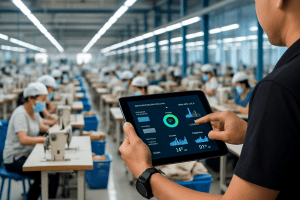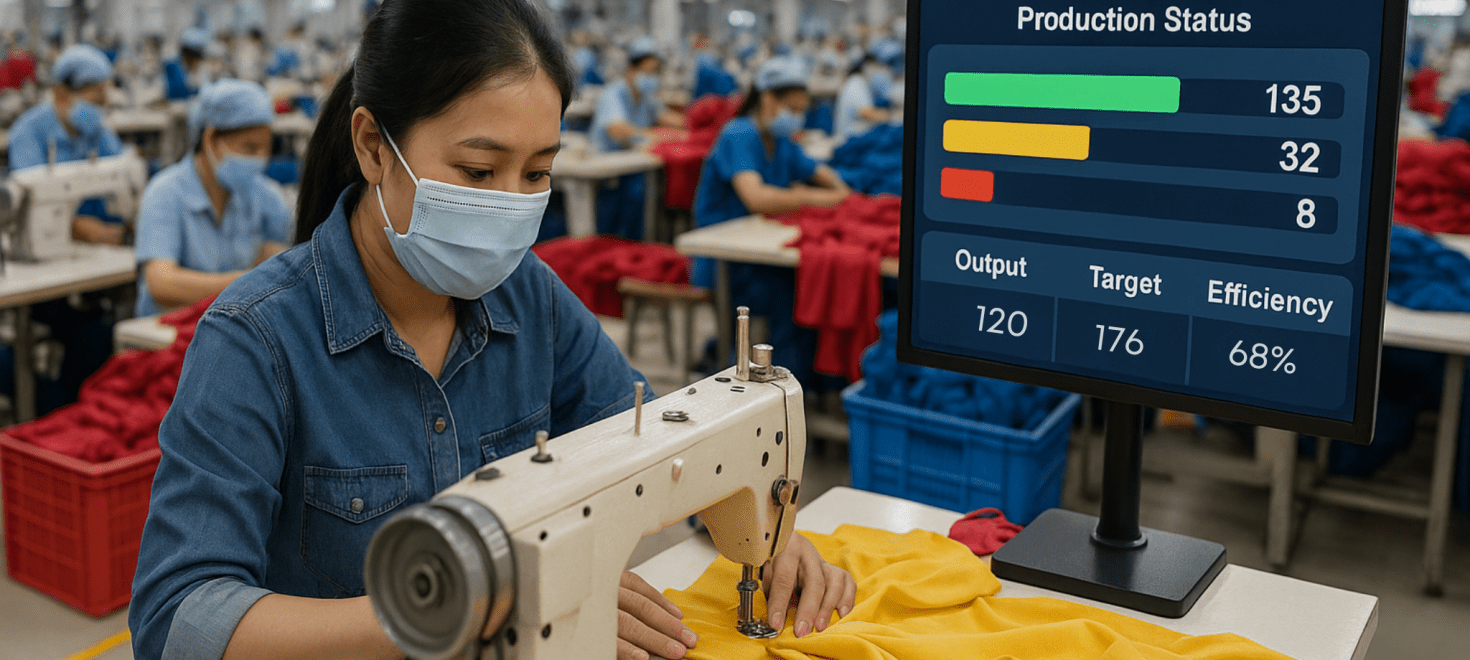Introduction: Stitching Together Speed and Precision
Vietnam’s rise as a manufacturing hub has always been powered by skilled labor, ethical practices, and strong trade agreements. But today, staying competitive means doing more than producing large volumes—it means reacting fast when changeover time, materials are delayed, or styles are modified mid-production.
The difference-maker? Data.
Factories are now blending manpower with real-time information, so managers can track exactly what’s happening on the shopfloor—whether it’s a line’s output, a machine’s downtime, or an operator’s efficiency.
Global fashion brands now demand not just fast production, but also real-time visibility, traceability, and measurable performance. Vietnamese manufacturers are responding by introducing factory-wide KPIs, digital dashboards, and real-time monitoring systems that turn raw production floors into smart, connected workplaces
The New Metrics of Manufacturing: Why Data Matters More Than Ever
In today’s apparel industry, a finished garment is only part of what the buyer wants. Equally important is the assurance that the production process is compliant, efficient, and on schedule. Brands are increasingly asking for live updates, predictive timelines, and transparent documentation of each production phase.
This is where Key Performance Indicators (KPIs) come in:
- Efficiency rate – How much of the planned work is actually completed
- Work in Progress (WIP) – How many garments are mid-production
- DHU (Defects per Hundred Units) – How many defects are occurring
- Line Target vs Achievement – Whether output is meeting the daily plan
When tracked digitally, these metrics give everyone—from supervisors to factory heads—clear visibility into performance. Problems can be fixed early, instead of after delays or rework.
KPI-Driven Floor Management: From Whiteboards to Dashboards
In many Vietnamese factories, traditional tools like handwritten charts and manually updated Excel sheets are giving way to floor-mounted dashboards and smart tablets. This digital shift enhances transparency and accelerates problem-solving.
- Operators can instantly see their targets and progress.
- Supervisors get real-time alerts when performance dips.
- RFID tags track garments at each stage, from cutting to finishing.
This democratization of data is changing factory culture. Rather than relying solely on instinct or experience, decision-making is becoming evidence-based and collaborative. It also builds trust with buyers, who can now receive data snapshots and live updates during critical production stages.
Real-Time Monitoring: Dashboards That Power Decisions
Real-time dashboards are fast becoming the nerve center of modern apparel factories in Vietnam. These systems pull data from multiple sources—cutting rooms, sewing lines, finishing areas—and consolidate it into visual formats that can be accessed by production heads, planning teams, and even clients.
With platforms like GPRO, FastReact, and Infor CloudSuite, manufacturers can track output, downtime, machine utilization, and absenteeism with high precision. This level of granularity enables agile decision-making. If a line is underperforming, corrective action—be it a technician’s intervention or reallocation of manpower—can be initiated immediately.
For example, if Line 7 consistently lags in output, IE engineers can examine whether it’s a layout issue, a skill mismatch, or machine downtime. Data eliminates guesswork and provides clarity. The result is improved On-Time In-Full (OTIF) delivery, reduced rework, and enhanced client satisfaction.
The IE-Tech Nexus: Driving Productivity Through Smart Analytics
Industrial Engineering (IE) has always played a crucial role in optimizing garment production. But in the era of data, the function of IE is evolving. Traditional time-and-motion studies are now being conducted using digital video analysis tools. Line balancing, which once took days to finalize, is now simulated using software platforms that consider multiple variables in real time.

Industrial Engineers (IEs) are now using digital tools instead of clipboards:
- Digital time-motion studies speed up line balancing decisions.
- Skill mapping software assigns the right tasks to the right operators.
- AI-based planning tools forecast delivery timelines based on real conditions.
The integration of IE with tech not only improves efficiency but also enhances the adaptability of manufacturing systems. Whether it’s adjusting to a new style or scaling up for a large order, data-backed IE practices allow factories to respond with speed and precision.
Example: Saitex International – Turning Denim into a Digital-First Operation
Saitex International, Vietnam’s leading sustainable denim manufacturer, has become a benchmark for data-driven apparel production. While the company is globally known for its eco-friendly credentials—recycling 98% of water, reducing energy usage by 85%, and turning sludge into bricks—it has quietly built one of the most digitally integrated denim factories in Southeast Asia.
Saitex’s model shows that data-driven manufacturing isn’t just for high-volume fast fashion—it’s equally critical for premium, sustainable production. By blending IoT, MES, and cloud analytics with lean manufacturing principles, the company has proven that efficiency and sustainability can reinforce each other in Vietnam’s growing apparel sector.
Factory-Wide KPI Monitoring
Inside Saitex’s Ho Chi Minh City plant, each production line is linked to a central Manufacturing Execution System (MES). Operators scan work orders via RFID tags, and every stage—from fabric cutting to final finishing—is tracked in real time. Key metrics such as line efficiency, defects per hundred units (DHU), and work-in-progress (WIP) levels are displayed on digital dashboards installed across the production floor.
Challenges in Implementation: Where the Numbers Don’t Always Add Up
Despite its promise, the path to data maturity in Vietnamese apparel manufacturing is not without challenges. Many small and mid-sized enterprises lack the capital to invest in full-fledged digital systems. Even when tools are installed, they may be underutilized due to inadequate training or resistance from staff.
Supervisors accustomed to manual methods may view digitization as intrusive or unnecessary. Fragmentation of data—with separate systems for planning, HR, and quality—can also hinder effective decision-making. Moreover, unless data is actively used in performance reviews, incentives, and operational planning, it risks becoming ornamental.
To unlock the full value of data, factories must embed it into their culture. This means investing in user-friendly systems, training at all levels, and aligning KPIs with business goals.
Building a Data-Mature Manufacturing Culture
Transitioning from isolated digital tools to a fully data-mature culture requires a deliberate strategy. This includes standardizing KPIs across departments, linking performance metrics to incentives, and fostering a mindset where data is not feared but embraced.
Training is essential. Line supervisors, often the backbone of execution, must be empowered to read and respond to data in real time. Middle managers should be trained to translate dashboard insights into tactical changes. And at the leadership level, data should inform strategic decisions—from capital investments to client pricing negotiations.
Public institutions and donor agencies also have a role to play. Initiatives by VITAS, GIZ, and IFC to promote tech adoption and digital training can accelerate this transition, particularly for MSMEs.
The Competitive Advantage of Measurable Manufacturing
In the age of traceability and fast fashion, data is no longer a backend function—it is front and center. Buyers are gravitating toward suppliers who can offer not just competitive pricing but live production updates, transparency, and the ability to forecast and adjust.
Factories that leverage data to reduce waste, improve quality, and optimize capacity enjoy better margins and stronger client relationships. As sourcing shifts toward partners that can provide agility without compromising on compliance or quality, Vietnam’s ability to offer a measurable, data-backed production ecosystem could be its defining edge.
From Metrics to Mindset
Vietnam’s apparel industry is at a pivotal moment. The fundamentals—skilled labor, ethical compliance, and production infrastructure—are strong. But the next leap will come from adopting a new mindset: one that values data as much as fabric, and dashboards as much as machines.
The factories that embrace this shift will not only stay relevant but will redefine what it means to manufacture garments in the 21st century. In the race from needle to numbers, Vietnam is well-positioned to lead—but the pace of adoption will determine just how far ahead it stays.
With deep expertise in lean manufacturing, digital enablement, and workforce skilling, Groyyo Consulting has been actively working with factories to implement data-centric practices. From conducting diagnostic assessments to redesigning IE systems and training shopfloor teams, helping bridge the gap between traditional operations and next-generation manufacturing capabilities.

Divya Mohan
General Manager (International Business)
divyamohan@groyyo.com


Leave a Comment